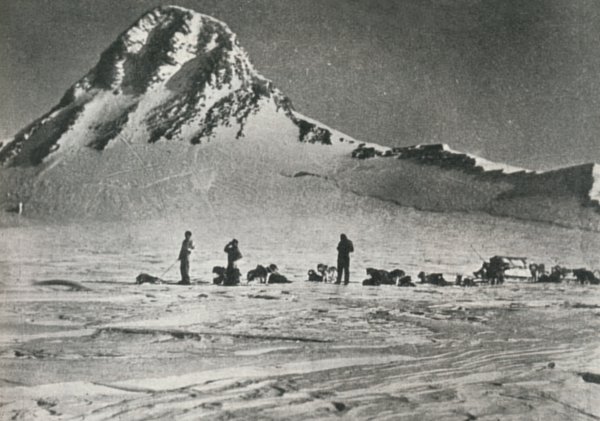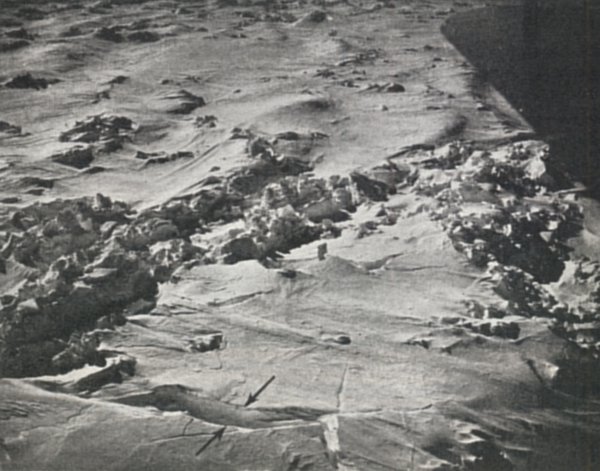|
By HAROLD F. BLANCHARD Technical Editor of MoToR |
 |
CAN YOU IMAGINE driving all
over the Antarctic in a motor car? Not only to the Pole
itself, which is 750 miles south from the Bay of Whales,
but to everywhere else of interest except where high
mountains get in the way or where there are areas with
deep crevasses too broad to cross. Yet that is exactly
what the Snow Cruiser was built to do.
 |
There is gold and platinum in
some of the mountains, stone for building houses and coal
for heat. All that is lacking is transportation which may
some day be provided by a fleet of snow cruisers to take
supplies to the mines and bring back precious metals. Such
is the dream of a certain professor.

|
The immediate purpose of the Snow Cruiser, however, as part of the U. S. Antarctic Service under Admiral Byrd's command, is to speed up exploration work and scientific investigation as well as to claim the continent as a United States possession by maintaining colonies there for three years as required by international agreement. Assisted by a five-passenger airplane, it is believed that the Snow Cruiser will add as much to the knowledge of the South Polar regions in two or three months as all previous expeditions combined. This plane, along with others, is expected to map most of the South Polar Continent by means of aerial cameras. The Snow Cruiser, world's newest and largest automobile, has almost nothing in common with conventional cars except that it runs on four pneumatic tires, but even this comparison is not exact because the tires are so large and soft that a spring suspension is unnecessary. Unlike an ordinary car, it has two engines instead of one, four-wheel drive, four-wheel steering by two levers instead of a steering wheel, two accelerator pedals, two brake pedals, a built in hydraulic jack on each wheel, enough Diesel fuel for a 5000-mile run (2500 gallons), 1000 gallons of airplane gasoline, bunks for four men and food for a year.
With ordinary cars, a potential
buyer might look to acquire an auto refinance loan in
order to purchase the car of their dreams; however with an
automobile as large as the Snow Cruiser, an individual
would need a lot of money at their disposal since its very
unlikely that any bank or auto refinance agency would be
willing to help someone out with such a grand undertaking.

|
Two 150 hp six-cylinder Diesel
engines drive electric generators which supply current to
a 75 hp motor in the hub of each wheel. Wheels are steered
by oil at 2000 pounds pressure under the guidance of two
levers located at either side of the driver who sits in an
individual chair in the center of the control room. The
right lever steers the front wheels and the left one the
rear.

|
Hydraulic band brakes, actuated by the same oil pressure, are controlled by a pair of treadle pedals operated by the driver's left foot, one pedal for front brakes and the other for rear. Similarly, the Diesel engines are controlled by two treadles depressed by the right foot. Normally one Diesel engine drives the front wheels and the other the rear, although either engine may be used to drive all four wheels. Toward the rear of the driver's seat are two long levers which are electrical controllers for the front and rear wheel motors. They connect the two motors in parallel for starting or climbing a grade and in series for running. They also enable the wheel motors to be used as brakes when descending long grades since the hydraulic brakes are intended for occasional or emergency use, brake lining area being insufficient for continued retardation of this 75,000-pound vehicle.
The Diesel engines are started
by operating two switches underneath the flat instrument
board. The two controller levers are then moved from
neutral to connect the pair of front and rear motors in
parallel, the engines are speeded up and the Cruiser
glides away after the driver has given two warning toots
on a dual horn to tell the crew to get aboard and to draw
up the boarding ladder which hangs down to the road from
the door in the engine room.

|
In normal operation the driver
sits with one hand on each steering lever and his right
foot on the two Diesel pedals. The left lever is
ordinarily kept in neutral position with rear wheels
pointed parallel fore and aft while steering is done by
the right lever controlling the front wheels. The motion
of the driver's arm in steering is spasmodic. When the car
is on its course he holds the lever in neutral, moving it
now and then, either back or ahead as the Cruiser needs
correcting toward right or left. The motion is much like
that of a steering wheel rim on a car which has a little
play in the steering mechanism.

|
Each wheel, including its
motor, is mounted on a tall kingpin which is nearly a foot
in diameter. As shown in the plan view the wheel
position is maintained by two telescopic struts,
forming a V, which are hydraulically operated by 2000
pounds oil pressure controlled by the steering lever. In
other words, to swing a wheel, the steering lever opens
valves which apply oil pressure to one strut piston and
reduce oil pressure on the other. With steering lever in
neutral position, the valves to both pistons are closed
and the wheel is securely held in the position it had when
the lever was last moved to neutral. Pistons on right and
left wheels are interconnected so that ordinarily the two
wheels move in unison but they may be turned separately
when desired, as when negotiating a right-angled street
intersection. Such a sharp turn is taken at one mph or
less. At this low speed, the pressure supplied by the
control oil pump is insufficient to swing both front
wheels at once. Hence they are turned separately, by
operating valves underneath the instrument board in
conjunction with the steering lever. As shown in one of
the photographs the wheels are readily brought back to
parallel position with the aid of an instrument directly
in front of the driver.

|
How the Cruiser Is Steered
During the writer's ride from Schenectady, N. Y., to Pittsfield, Mass., steering was done entirely by the front wheels except when we stopped at a roadside restaurant for a late lunch. There, all four wheels were swung to the right to move the Cruiser off the road into a convenient parking area.
Throughout the trip, the driver, who was Dr. Thomas C. Poulter, designer of the Snow Cruiser, always kept his left hand on the rear wheel steering lever ready for any emergency which might require swinging the rear to one side or the other.
Maximum swing of wheels is 25 degrees which enables the outside wheels to turn on a radius of about 37 feet when the front wheels are deflected all the way in one direction and the rear wheels are oppositely pointed. With a wheelbase of 20 feet, this 55-foot long ship overhangs the front wheels 18 feet and the rear wheels 17 feet. Its tread is 14 feet, body width 15 feet and overall width from hub to hub is 19 feet 8 inches. Therefore, even with a comparatively small turning radius it requires considerable space for maneuvering. Overall height is 15 feet, a dimension to be considered in selecting bridges.
Maximum speed of the Cruiser is undoubtedly in excess of 30 mph but whether this rate will ever be attained over Antarctic snows is a question. Certainly it is too fast for concrete roads because of the pitching of this spring less vehicle on its huge tires which incidentally are 10 feet in diameter, 33.5 inches in section and are mounted on 66-inch rims.
These tires, inflated to only
15 pounds per square inch, provided a comfortable spring
suspension except, of course, there is no way to attach
shock absorbers to control tire action. Therefore at a
speed of only 15 mph it was not unusual for the
extremities of the vehicle to bob up and down a few inches
when a stretch of wavy concrete was encountered, and once,
when traveling nearly 30 mph, a wavy surface caused a
motion of at least a foot.

|
Speed during the 60-mile trip from Schenectady to Pittsfield varied considerably. On the level it ranged from 15 to 25 mph or more depending on width of road and smoothness. Being nearly 20 feet wide, the Cruiser so fully occupied modern two-lane concrete roads that sometimes speed had to be reduced on them. On one such road, a bridge was crossed where the clearance at either side was less than six inches. It was taken at a snail's pace with four men on the top of the cruiser each watching the clearance of one hub. Back in Ohio a bridge was found which was exactly 20 feet wide which left a total clearance of four inches. It took three hours to cross it.
Driving out of Schenectady, nearly an hour was consumed on a street which, with cars parked along either curb, left about a foot to spare on either side. However, outside of an occasional street which was too narrow for comfort, there was no difficulty with parked cars or with traffic. In New York State, for example, a half dozen police cars running two abreast preceded the cruiser. Farther ahead were other police cars and/or motorcycles which ordered all approaching vehicles to pull onto the road shoulders and stop. Vehicles following from behind were not allowed to pass. Thus the Cruiser had the road entirely to itself. Considering its low average speed this was tough on the cars following but there seemed to be no other solution.
Speed upgrade was perforce reduced as with all other motor vehicles. Furthermore, the weather was entirely too "hot" to permit the engines on this Polar machine to be run at full power without overheating. Atmospheric temperature was about 40 above zero whereas normal Summer temperature in the Antarctic is 10 below and 80 or more below in Winter. At 40 degrees above, with all doors and windows open, the engine room reached a temperature of 150 degrees on long hills, which was entirely too hot to permit effective cooling of the radiators which are located directly ahead of the engines and therefore take their air from the engine room instead of from outside. It was so hot that the handles on the short ladder leading up into the control room were too warm to grasp for more than a moment. Hence it was necessary to run the engines at less than full power when ascending a steep grade of any length, such as Lebanon Mountain, leading into Pittsfield, which was negotiated at about 5 mph.
Down in the Antarctic with both engines running at full load it is expected that all four windows and perhaps the door also will have to be left open to keep the engine room temperature within reason. In view of the fact that the engines may burn more than 10 gallons of fuel per hour, which is enough to heat several ordinary houses, the heat in the engine room is readily understandable.
Downgrades Taken at Low Speed
Downgrades were also taken at reduced speed merely as a precaution. On descents of 10 per cent or more, the speed was cut to 5 mph.
Stops were frequent. Luncheon took more time than anticipated. There was a halt at the Gurley plant in Troy for a number of scientific instruments. Another stop was necessary when the Massachusetts Police took over the escorting job. There were two stops to replace broken oil lines and another stop or two for inspection. Hence it took from noon to nearly 9 pm to drive the 60 miles from Schenectady to Pittsfield.
The tires were built by Goodyear in the same moulds used for the tires on the Gulf Refining Co.'s Marsh Buggies which are used for exploring Southern swamps for oil. The Snow Cruiser's tires, however, have twelve plies instead of four or six. They have a thin, smooth tread, total thickness of plies and tread being only an inch. Two spares are carried in the rear of the machine.
The tires have smooth treads
apparently because nonskid treads are unnecessary for
Antarctic conditions, although the cost of cutting
non-skid moulds perhaps was also a consideration. Another
reason will be mentioned in a moment.

|
The surface over which the Cruiser will travel in the Antarctic is largely, if not entirely, composed of small, hard crystals of ice which resemble sand from a standpoint of motor vehicle traction. Underneath is a layer of ice ranging in thickness from perhaps 50 up to several hundred feet which rests on the Antarctic Ocean for roughly 300 or 400 miles south from the base at Little America but from there on the layers of snow and ice lie upon a rocky continent with ranges of mountains at intervals. Going Southward toward the Pole the surface slopes gently upward to a plateau which has an elevation of 8000 to 11,000 feet. This entire surface, except where broken by mountains, is covered by a fine, sandlike snow.
The Snow Cruiser, with its enormous tires, was built to run successfully on such a surface. Dr. Poulter, its designer, was second in command and chief scientist, on the previous Byrd expedition where several tractors were used with some success. Some were of American manufacture with metal belts and others were French Citroens with metal belts in the rear and two wheels in front with pneumatic tires. The latter design has been used for some years on the Sahara Desert.
The tractors proved the worth of motorized equipment but they lacked living quarters and they were unable to cross crevasses which are to be found in numerous areas. The width of a crevasse may be anything from a narrow slit to a chasm 50 feet or more wide. Its depth varies from a few feet to possibly several hundred. Most of these cracks, however, are less than 15 feet wide and the Snow Cruiser has been designed to cross them. Areas with wider crevasses can be detoured. Some of the crevasses are concealed by snow but are readily detected in good light by a difference in color of the surface.
How Crevasses Will Be Crossed

|
To cross a crevasse, the front wheels of the Cruiser are driven up to the brink, and lifted up, by operation of the built-in jacks, until the front of the ship rests on the four steel runners which extend the full length of the underbody curving up at the ends as on a toboggan. Next the rear wheels are used to push the Cruiser forward until they reach the brink. Then the front wheels are jacked down until the front is lifted clear of the snow and the rear wheels are jacked up, permitting the front wheels to tow the rest of the vehicle across the chasm on its runners.
The Snow Cruiser was successfully tested in the sand dunes on Lake Michigan. Whereas a large truck quickly sunk to its hubs and had to be towed out by a tractor the Cruiser tires, with a contact area of nearly 9 square feet each, only sunk into the sand an inch or so.
Rubber becomes brittle at a temperature of 72 degrees below zero while temperatures to be encountered may run more than 80 below. No difficulty is expected while the vehicle is in motion because of heat generated by the flexing of the tires-although the heat might not be sufficient to prevent non-skid tread buttons becoming brittle enough to break off. However, if Dr. Poulter drives the Cruiser to the Pole and parks there for several days, as he plans to do, or if a long stop is made anywhere along the way when temperatures are too low, all four wheels will be jacked up. When ready to proceed, the tires will be covered with curtains and warmed up above the brittle point, the front ones by engine exhaust and the rears by blow torches.
To permit adjusting tire pressure for altitude or temperature, or to compensate for a small leak, it is proposed to install apparatus for regulation of tire pressure from the control room. This scheme is not as difficult as it sounds.
Since the tires make only 200 revolutions per mile, double reduction bevel gearing is necessary between each wheel and its motor.
A tire and its rim weigh 3100 pounds. In case one has to be changed there is provision for attaching a derrick at four points in the roof of the Cruiser adjacent to the tire.
The Cruiser is equipped with two powerful headlamps for driving through the long Antarctic night. To mark the trail, reflector units, visible in all directions for 15 miles, will be used.
A two-way radio unit will keep the crew in touch with the other groups in the expedition.
The Snow Cruiser was built in
three months by the Research Foundation of Armour
Institute of Technology which owns the ship. Its
construction, costing $150,000, was financed by friends of
the Institute and 80 manufacturers. Principal units in its
makeup include a special alloy steel body built by the
Pullman company, two six-cylinder 672 cubic inch, 150 hp
Cummings Diesel engines, General Electric generators and.
motors, and controls for steering, braking and jacking, by
Hydraulic Controls Inc. The airplane is a specially
designed Beechcraft with a 350 hp Wright Whirlwind engine.